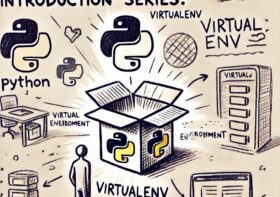Mastering Ubuntu on WSL2: Essential Linux Commands for Efficient Work

Your Comprehensive Guide to Navigating, Managing, and Optimizing Ubuntu on Windows Subsystem for Linux (WSL 2)
Table of Contents
Brief Overview of WSL 2 and Its Benefits
What WSL 2 Is and How It Differs from WSL 1
Windows Subsystem for Linux (WSL) is a compatibility layer for running Linux binary executables natively on Windows 10 and Windows Server 2019. Microsoft developed WSL to bridge the gap between Windows and Linux environments, providing developers with the flexibility to use Linux tools on a Windows system.
WSL1 was the first version, introduced in 2016, and it worked by translating Linux system calls into Windows system calls, allowing Linux applications to run on the Windows kernel. While effective, WSL1 had some limitations, especially in terms of compatibility and performance for certain Linux applications.
WSL2, introduced in 2020, is a significant upgrade over WSL1. The key differences and improvements include:
- Full Linux Kernel:
- WSL2 includes a complete Linux kernel running in a lightweight virtual machine (VM). This kernel is managed and updated by Microsoft, ensuring it is up-to-date with the latest Linux improvements and features.
- Performance Improvements:
- WSL2 offers faster file system performance, significantly improving the speed of file operations. This is particularly beneficial for developers who work with large codebases and need efficient access to files.
- Enhanced Compatibility:
- The full Linux kernel in WSL2 ensures broader compatibility with Linux applications, especially those that rely on low-level system calls and kernel features.
- Full System Call Compatibility:
- WSL2 supports full system call compatibility, meaning applications that require specific system calls can now run seamlessly, which was a challenge in WSL1.
- Integration with Windows:
- WSL2 allows for better integration with Windows tools and workflows. For example, you can access Windows files from within the Linux environment and vice versa, enabling smooth interoperability.
Benefits of Using Linux on Windows for Development, Testing, and Productivity
- Access to Linux Tools on Windows:
- Developers can use Linux-native tools and utilities directly on their Windows machines without the need for dual-booting or running a separate virtual machine. This includes popular tools like
bash,git,ssh,sed,awk, and many others.
- Developers can use Linux-native tools and utilities directly on their Windows machines without the need for dual-booting or running a separate virtual machine. This includes popular tools like
- Streamlined Development Workflow:
- WSL2 enables a seamless development workflow by allowing developers to code, build, and test applications within a Linux environment while still using their favorite Windows development tools, such as Visual Studio Code.
- Improved File System Performance:
- With WSL2’s enhanced file system performance, operations that involve reading and writing large numbers of files (such as compiling code or managing version control repositories) are much faster.
- Testing in a Native Linux Environment:
- Developers can test their applications in a real Linux environment without leaving Windows. This ensures that applications will run correctly on production Linux servers.
- Ease of Setup and Maintenance:
- Setting up WSL2 is straightforward, and it does not require complex configuration or resource allocation like traditional virtual machines. Microsoft manages the Linux kernel updates, reducing maintenance overhead for users.
- Reduced System Resource Usage:
- WSL2 uses a lightweight VM, which is more resource-efficient compared to running a full virtual machine. This means less memory and CPU usage, leaving more resources available for other tasks.
- Interoperability Between Windows and Linux:
- WSL2 allows users to seamlessly switch between Windows and Linux environments. Files can be accessed and edited from both sides, and Windows applications can interact with Linux applications and vice versa.
- Enhanced Security:
- Running Linux applications within WSL2 provides a secure environment isolated from the main Windows system. This can be particularly useful for running potentially untrusted code.
- Support for Docker and Containerization:
- WSL2 supports Docker, allowing developers to run Docker containers natively on Windows without needing a separate Linux VM. This is a significant advantage for modern DevOps practices and containerized application development.
- Continuous Integration and Deployment (CI/CD):
- WSL2 makes it easier to integrate Linux-based CI/CD pipelines directly on Windows machines, improving the efficiency of the development and deployment process.
Importance of Mastering Linux Commands for Productivity
Mastering Linux commands is crucial for productivity as it allows users to perform tasks quickly, efficiently, and with greater control. Understanding and utilizing these commands can significantly enhance one’s ability to manage files, processes, and system configurations, leading to a more streamlined workflow.
How Linux Commands Streamline Works
- Efficiency and Speed:
- Automation: Linux commands enable the automation of repetitive tasks through scripting. Shell scripts can automate backups, file transfers, system updates, and more, saving time and reducing the chance of human error.
- Batch Processing: Commands like
cp,mv,rm, andgrepcan handle multiple files at once, making it easy to perform bulk operations that would be tedious with a graphical user interface (GUI).
- Precision and Control:
- Granular File Management: Commands like
find,rsync, andchmodoffer precise control over file management, permissions, and synchronization, allowing users to handle complex directory structures and permissions with ease. - Process Management: Tools such as
ps,top, andkillallow users to monitor and control system processes accurately, identifying and terminating resource-hogging applications efficiently.
- Granular File Management: Commands like
- Flexibility and Customization:
- Command Chaining: Using pipes (
|) and redirection (>,>>,<), users can combine multiple commands to create powerful one-liners that perform complex tasks. For example,grepcombined withawkcan filter and format text data quickly. - Custom Aliases and Functions: Users can define custom aliases and functions in their shell configuration files (like
.bashrcor.zshrc) to create shortcuts for frequently used commands, further speeding up their workflow.
- Command Chaining: Using pipes (
- Access to Powerful Tools:
- Text Processing: Tools like
sed,awk, andcutare incredibly powerful for processing and transforming text data, making them invaluable for tasks like log analysis, data extraction, and report generation. - Networking Utilities: Commands like
curl,wget,ssh, andnetcatprovide robust networking capabilities, allowing users to download files, connect to remote servers, and test network configurations effortlessly.
- Text Processing: Tools like
Relevance to Developers, System Administrators, and Power Users
- Developers:
- Version Control: Proficiency with commands like
gitfor version control is essential for collaborative coding, managing code repositories, and handling branches and merges. - Development Environment Setup: Installing and configuring development environments, including dependencies, virtual environments, and containerization (with tools like Docker), is streamlined with Linux commands.
- Debugging and Testing: Commands such as
gdbfor debugging,stracefor tracing system calls, andvalgrindfor memory profiling are indispensable for diagnosing and fixing code issues.
- Version Control: Proficiency with commands like
- System Administrators:
- System Monitoring and Maintenance: Regularly monitoring system health using commands like
top,htop,vmstat, andiostatensures optimal performance and early detection of issues. - User Management: Efficiently managing user accounts, permissions, and groups with commands like
adduser,usermod,chown, andchmodis critical for maintaining system security and organization. - Backup and Recovery: Automating backups with tools like
rsyncandtar, and recovering data usingddandfsck, ensures data integrity and quick recovery in case of failures.
- System Monitoring and Maintenance: Regularly monitoring system health using commands like
- Power Users:
- Customization: Power users often customize their environments extensively, using commands to tweak system settings, configure startup scripts, and optimize their user experience.
- Advanced File Management: Power users leverage commands like
lnfor symbolic linking,difffor file comparison, andsortfor organizing data, enabling advanced file operations that go beyond basic usage. - Data Analysis and Processing: For those handling large datasets or logs, commands like
grep,awk,sed, andsortare crucial for quick data analysis, transformation, and extraction.
You can get the essential guide on WLS 2 at:
Master WSL 2: A Concise Guide for Windows Subsystem for Linux
Basic Linux Commands
Updating and upgrading packages
sudo apt update
sudo apt upgradeNavigating the file system
ls # List directory contents
cd # Change directory
pwd # Print working directory
mkdir # Make directory
rmdir # Remove directoryFile operations
Basic file manipulation
cp source destination # Copy files
mv source destination # Move or rename files
rm file # Remove files
rm -r directory # Remove directories recursively
touch file # Create empty files or update timestampsViewing and editing files
#Viewing file
cat file # Concatenate and display file
less file # View file contents page by page
head file # Display the first 10 lines of a file
tail file # Display the last 10 lines of a file
#Editing file
nano file # Edit file with nano editor
vi file # Edit file with vi editorSystem Information and Monitoring
Real-time monitoring system tasks and processes
top # Display all running processes
htop # Interactive process viewer (requires installation)
free -h # Display memory usage in human-readable format
df -h # Display disk space usage in human-readable format
du -h dir # Display disk usage of a directory in human-readable format
uname -a # Display system informationNetwork information
ifconfig # Display network interfaces
ip addr # Show IP addresses
ping hostname # Test network connectivity
netstat -tuln # List network connections and listening portsUser and Permission Management
Managing users
sudo adduser username # Add a new user
sudo deluser username # Remove a user
sudo passwd username # Change a user's passwordManaging permissions
chmod permissions file # Change file permissions
chown owner:group file # Change file owner and groupProcess Management
Listing and managing processes
ps # List current shell processes
ps aux # List all running processes
kill PID # Terminate a process by PID
killall name # Terminate all processes with the given namePackage Management
Installing and removing packages
sudo apt install package-name # Install a package
sudo apt remove package-name # Remove a package
sudo apt purge package-name # Remove a package and its config filesSearching for packages
apt search keyword # Search for packages
apt show package-name # Show package detailsSystem Administration
Managing system services
sudo systemctl start service # Start a service
sudo systemctl stop service # Stop a service
sudo systemctl restart service # Restart a service
sudo systemctl status service # Check service statusHandling log files
tail -f /var/log/syslog # Follow the system logKeeping your system updated
sudo apt-get update # Update package lists
sudo apt-get upgrade # Upgrade all packagesAdditional Resources for Learning More About Linux and WSL2
For those looking to deepen their understanding of Linux and WSL2, there are numerous resources available, including official documentation, tutorials, books, and online communities. Here are some key resources:
Official Documentation
- WSL2 Official Documentation:
- Overview and Getting Started: Windows Subsystem for Linux Documentation This comprehensive guide covers installation, configuration, and usage of WSL2, including troubleshooting tips and best practices.
- WSL2 Kernel Updates: WSL2 Linux Kernel Updates Information about the Linux kernel updates provided by Microsoft for WSL2.
- Ubuntu Official Documentation:
- Ubuntu Documentation: Ubuntu Documentation This resource offers extensive guides on using Ubuntu, covering everything from basic setup to advanced system administration.
- Linux Command Reference:
- Linux Command Line Documentation: Linux Command Documentation A comprehensive manual (man) pages for Linux commands, providing detailed descriptions, options, and examples for each command.
Online Communities
- Stack Overflow:
- Linux and WSL Tags: Stack Overflow Linux Questions Stack Overflow WSL Questions A platform where you can ask questions and get answers from the developer community.
- Reddit:
- r/bash: Reddit r/bash A subreddit dedicated to shell scripting and command line usage.
- r/linux: Reddit r/linux A community for Linux users and enthusiasts to share news, tips, and discussions.
- r/WSL: Reddit r/WSL A subreddit focused on WSL, where users share experiences, troubleshoot issues, and discuss updates.
- GitHub:
- WSL Issues and Discussions: GitHub WSL Issues A place to report bugs, request features, and discuss WSL with the development team and other users.
These resources will provide you with a wealth of information and support as you learn more about Linux and WSL2. Whether you are a beginner looking to get started or an experienced user seeking to deepen your knowledge, these links will help you on your journey.




navarro pharmacy
Thanks to my father who told me about this website, this blog is actually remarkable.